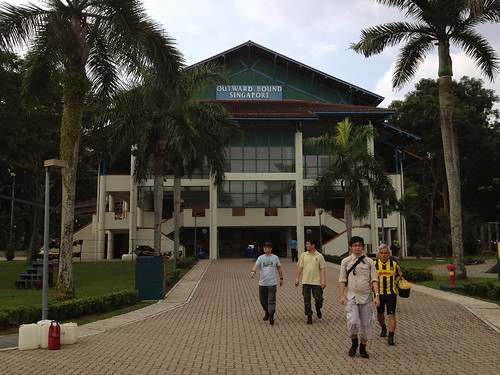
Our base of operations is at Outward Bound Singapore (OBS), on the western side of Pulau Ubin.
There were several teams; one group was over at Tuas, while another departed for Chek Jawa.
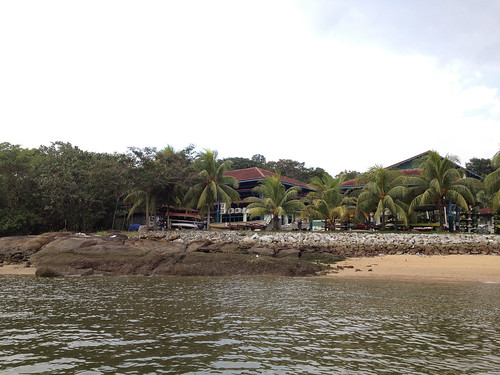
A small group of us, led by Dr. Tan Koh Siang, headed out in a small boat to visit some of the other shores of Ubin.
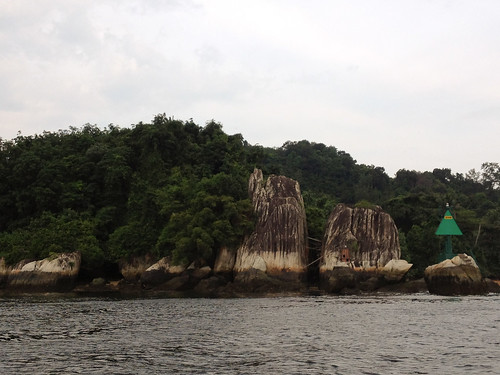
We landed at Tanjung Tajam, the western tip of the island. Given that this is a shore that we've never fully explored before, this was an exciting opportunity for both Kok Sheng and I.
NOTE: Due to various constraints, some of the photos posted here are not actually of marine creatures found specifically on today's trip; such photos would have been taken during visits to other locations, and are used here purely for illustrative purposes.
The shore here is mostly pebbles and broken bits of coral and shells, with lots of large boulders. Kok Sheng says that superficially, in terms of substrate, water conditions, and marine life found, Tanjung Tajam is a lot like Punggol.
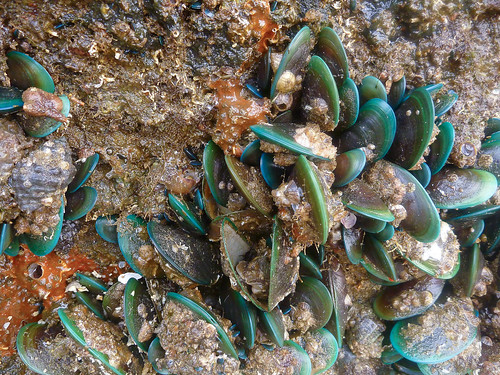
Green mussels (Perna viridis) and plain rock oysters (F. Ostreidae) dominated the lower portions of the boulders. Worm snails (F. Vermetidae) could be seen growing amongst them.
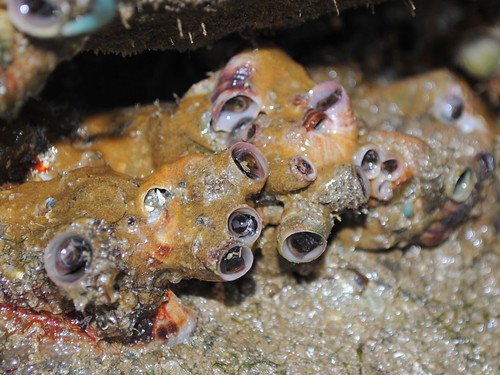
(Photo by Kok Sheng, from Punggol)


Spiral melongena (Pugilina cochlidium) were very abundant here. On most shores, the shells we encounter turn out to be empty ones occupied by hermit crabs, but here, every spiral melongena shell turned out to be a live snail.

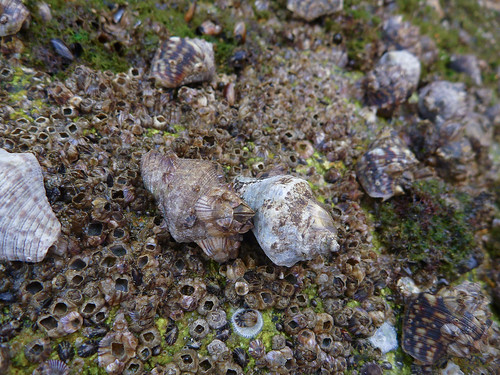

Other predatory snails like drills (F. Muricidae) were also very abundant. The taxonomy of drills in this part of the world can be quite confusing, especially since there can be plenty of variation between individuals.
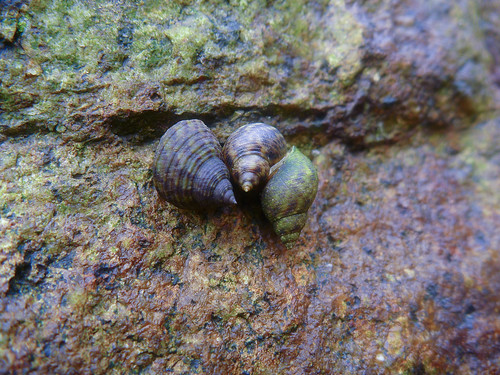

The higher sections of the boulders were the exclusive domain of the rock periwinkles (F. Littorinidae).
I found it interesting that here, among the typical rocky shore gastropods, one could also find species that are usually found in mangrove habitats.
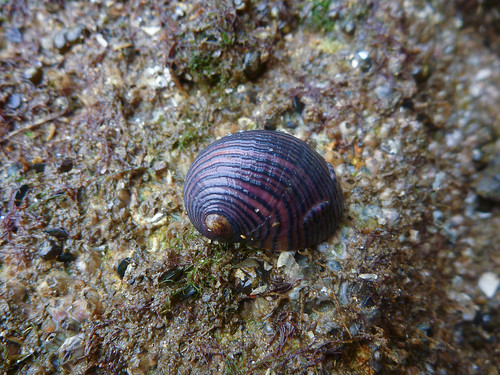

For instance, we didn't see any other nerite species except for lined nerites (Nerita articulata), while black-mouth mangrove periwinkles (Littoraria melanostoma) were found high up on the rocks, scattered among the rock periwinkles.
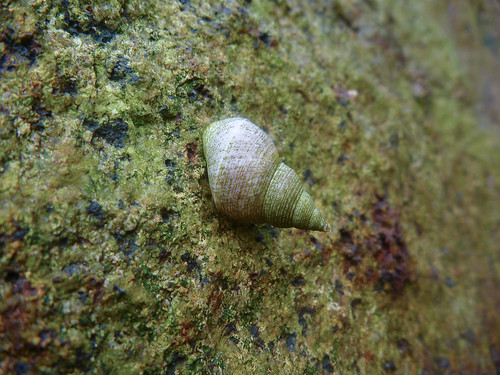

This onch slug was the only slug I could find on this shore.

Sponges, like this elegant branching sponge (Haliclona sp.), could be found on many of the larger rocks and boulders, but we couldn't spot any nudibranchs or flatworms.
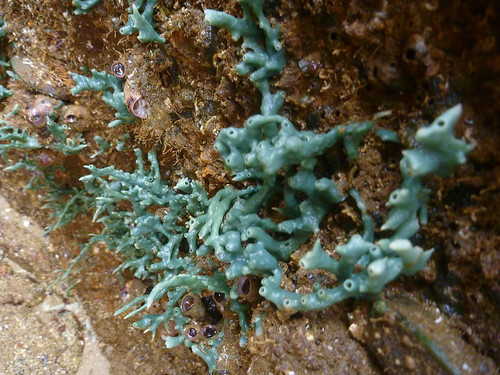

(Photo by James, from Punggol)
Purple climber crabs (Metopograpsus sp.) were commonly encountered, but naturally, they were very skittish and eluded our efforts at collecting or photographing them. Small stone crabs (Myomenippe hardwicki) were much easier to collect, as they could be revealed by flipping over rocks, while the adults were more likely to wedge themselves in crevices and resist attempts at dislodging them by brandishing their pincers.


I think this is an even tinier young stone crab, found sharing its hiding place with numerous marine springtails (Pseudanurida billitonensis).
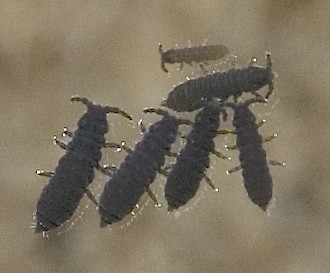
Marine springtails;
(Photo by Marcus, from Pasir Ris)
Other crabs found beneath rocks near the water's edge included tiny swimming crabs (F. Portunidae).

Is this a juvenile of a species of Thalamita?
(Photo by Kok Sheng, from Punggol)
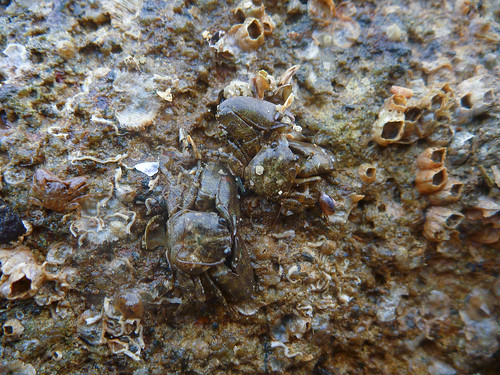
Many small porcelain crabs (F. Porcellanidae) could be seen scuttling for cover whenever a rock was flipped over.
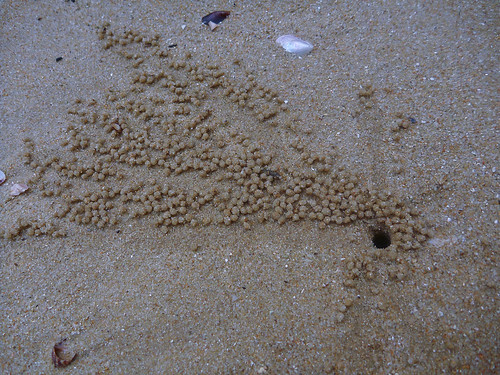
Burrows of sand bubbler crabs (Scopimera sp.) were present on the sandier areas of the shore.
There were some other tiny arthropods hiding beneath the rocks; while I was inspecting the underside of one such rock, Dr. Koh pointed out a tiny bright red speck that turned out to be a velvet mite. Was this a mite that lived naturally on the shore, or had it strayed from the nearby coastal forest?

This isn't an actual photo of the velvet mite we found on the shore, but to my untrained eye, all velvet mites honestly look the same to me. These arachnids are so tiny that it's impossible to identify them to the species level without a microscope;
(Photo by James, from Venus Drive)
I also collected a red amphipod (Amphipoda) from the same rock.
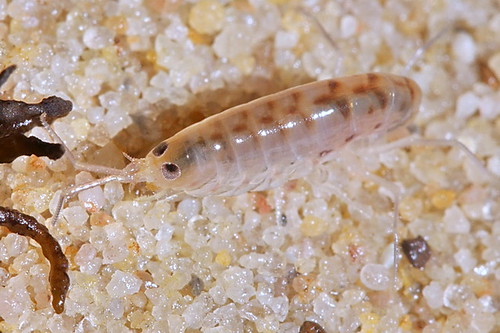
Something like this, but a deeper shade of maroon;
(Photo by James, from St. John's Island)

The tide was too high to look for sea fans, but there was a pool full of banded bead anemones (Anthopleura sp.).

Kok Sheng found a burgundy anemone (Bunodosoma goanense), which is a notable find.
This sea anemone was officially recorded in our waters only last year, but had been seen on a few occasions before; Ria found a small individual at Pasir Ris in 2008, while Siyang's blog post from 2009 is possibly the very first sighting of this species on the shores of Punggol. Subsequently, others like James and Kok Sheng found burgundy anemones at Punggol. Their identity remained a mystery for a while, until sea anemone expert Dr. Daphne Fautin visited Singapore, looked at some specimens, and finally managed to identify them as a species that was first described from the coasts of Goa, India. Dr. Fautin also mentioned in a talk last year that she had previously received photos of this same species occurring on some of our buoys.
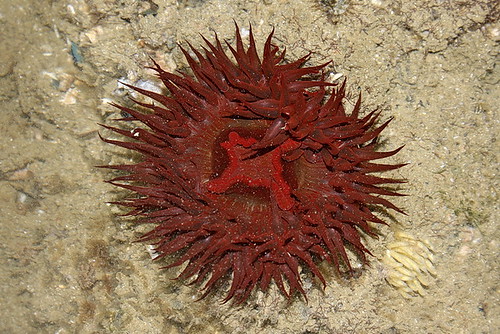
This is how it looks like in the water;
(Photo by James, from Punggol)
That such a large and distinctive-looking species could have gone unrecorded for so long suggests that there is so much more we've yet to discover about our marine biodiversity, a gap in our knowledge that the Mega Marine Survey is attempting to rectify.
This is possibly the first record for Pulau Ubin, and suggests that the species is more widely distributed along our northeastern shores. Despite our efforts, we were unable to dislodge and collect the anemone. It would have been something special for Dr. Fautin!
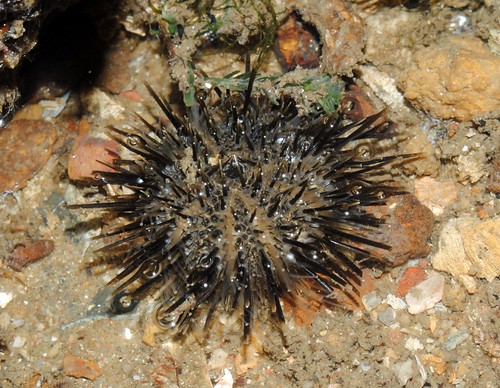
(Photo by Kok Sheng, from Punggol)
Kok Sheng, with his passion for echinoderms, also found black sea urchins (Temnopleurus sp.) and a crown sea star (Asterina coronata).
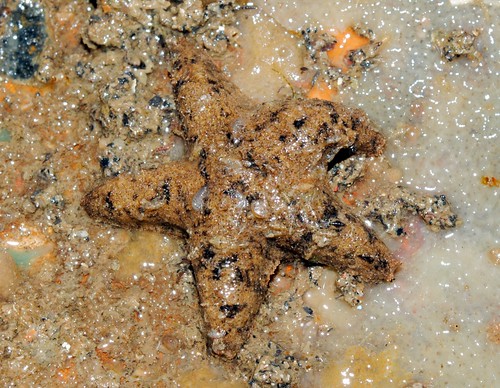
(Photo by Kok Sheng, from Punggol)

After a while, we decided to head further along the coast. It was difficult to find a suitable stretch of shore to explore, thanks in part to the fence that was erected in 2003 to prevent illegal immigrants from entering Singapore by landing on the northern coastline of the island. Whatever passed for a shore outside of the fence was mostly very narrow, and it was difficult for the boat to approach close enough for us to land safely.
We eventually found a patch that seemed a little wider, and landed.


Things didn't look too promising; it was much of the same common animals that we'd already found at Tanjung Tajam: green mussels, drills, and porcelain crabs. I collected more amphipods that were found hiding beneath a rock. Unlike the one I had collected earlier from Tanjung Tajam, these ones were black.
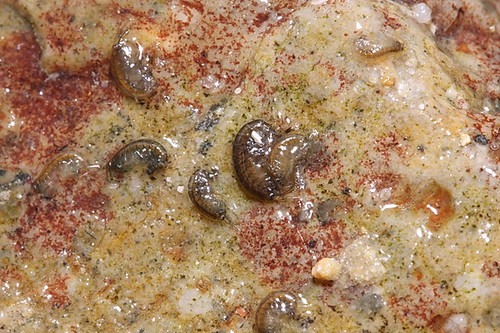
They looked something like this;
(Photo by James, from East Coast)
Before it got dark, we decided to call it a day, and headed back to OBS to wash up and deposit our specimens.
Base camp is divided into 2 main sections: there is an outdoor area for equipment storage and sorting of specimens.
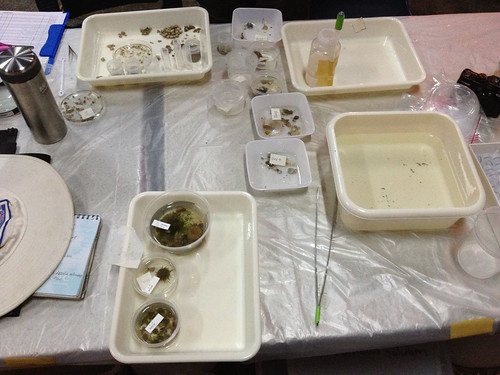

Some sampling techniques end up collecting a whole mess of specimens and assorted unwanted material, such as sand or mud. During the sorting process, the animals are found, picked out and separated from the sediment, and grouped together for further processing. It's tedious and time-consuming work, but extremely necessary. As an example, after a particular sample has been sorted, it's possible to take a quick glance through the datasheet and say, "Oh, we collected 23 brittle stars, 15 crabs, 17 clams, and 30 polychaete worms at a particular site."
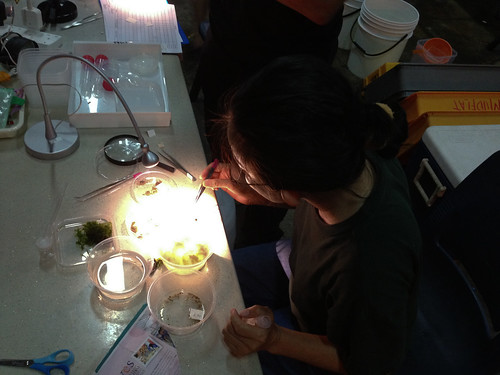
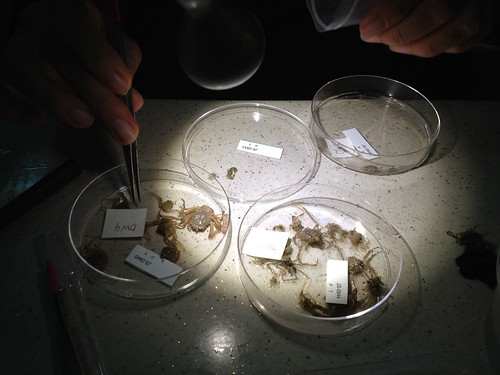
Here is an assortment of crabs which have been sorted. In this way, it's easier for scientists to take a closer look at a particular type of crab, and possibly compare between individuals to see if there are multiple species represented.
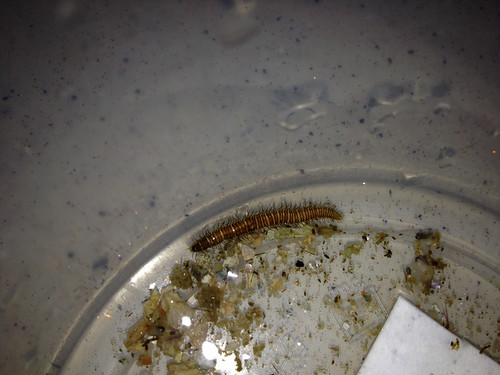
Something interesting turns up from the samples we collected; black sea urchins sometimes have a worm living as a commensal/parasite on the underside, near their mouthparts. In this case, we had brought back a black sea urchin, and this worm must have dropped off its host.

Here's an example of the worm as it's usually seen;
(Photo by James, from Changi)
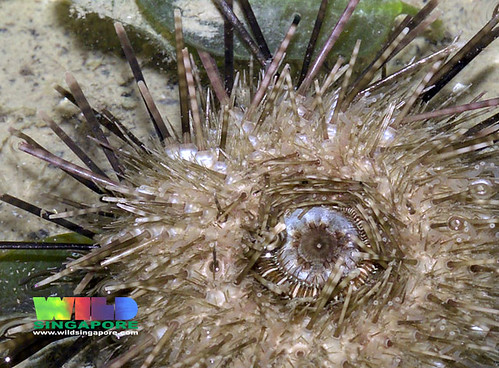
(Photo by Ria, from Changi)
One key element of the survey which cannot be overlooked is the labelling of specimens, and tracking of data. Each specimen that is collected is given a label and identification code, so that we know when and where it came from. Specimens may then be sent over for further processing, whether it's preservation, photography, or further examination by taxonomists, but as long as the label remains with the specimen, you won't suddenly end up with missing specimens, or specimens of unknown provenance. A specimen without accurate locality data is useless.
The indoor area serves as headquarters, photography, tissue sampling and cryogenic work, and taxonomic examination.

The specimens we collect go through a complicated process, and it's essential to make sure that everything is labelled accurately.
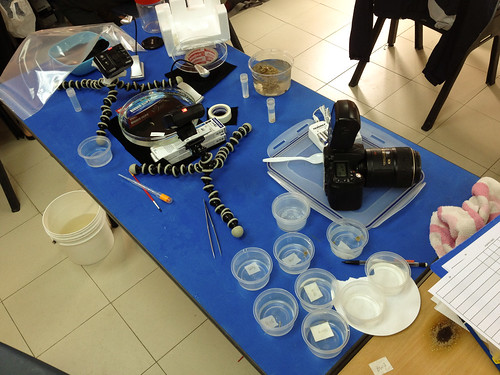
Selected specimens are photographed while still alive; many animals lose their colour and other notable identifying features once dead, so it's important to have high-quality images of the live animals in addition to the actual preserved specimens.


These sea urchins are waiting for their turn with the paparazzi.
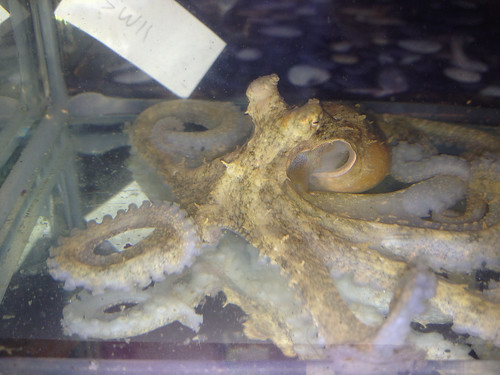
There is some excitement as a live octopus is brought in, collected from Kampung Melayu on Pulau Ubin earlier today.
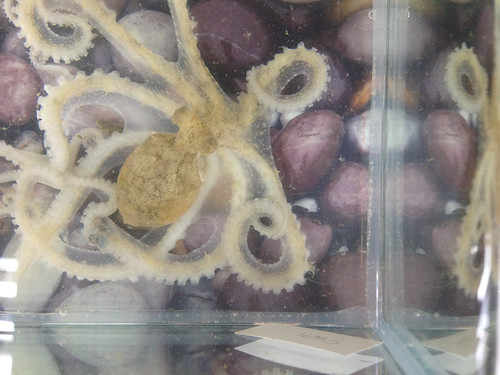

There is a small area where tissue samples are collected from some specimens and frozen, so as to preserve genetic material which can then be used in molecular studies. This is done with freshly collected specimens, as DNA quickly degrades over time, even if the organism is preserved in alcohol or formalin.
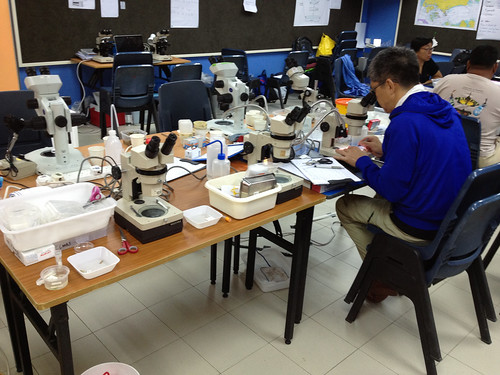
Another area has been set aside for microscopes; as mentioned earlier, some organisms are just so minute that it's best to examine them under the microscope. In other cases, some animals can only be conclusively identified after looking at certain features of their anatomy under high magnification.

A team comes in after a fishing trip, with lots of small fishes.
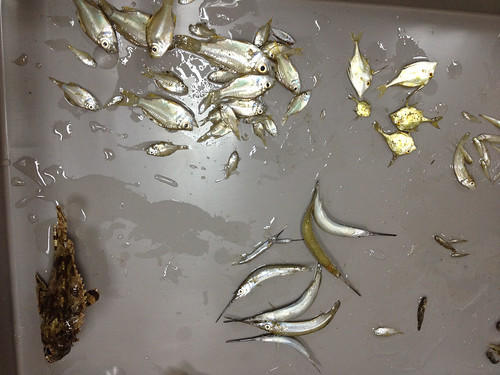

There is a slight lull, and then the team from Chek Jawa returns, with buckets full of new specimens to label, sort, and process.

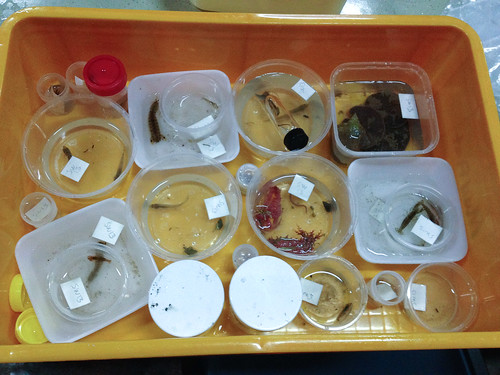

Siong Kiat eagerly inspects a garlic bread sea cucumber (Holothuria scabra) for tiny parasitic ulimid snails (F. Eulimidae) on its skin.
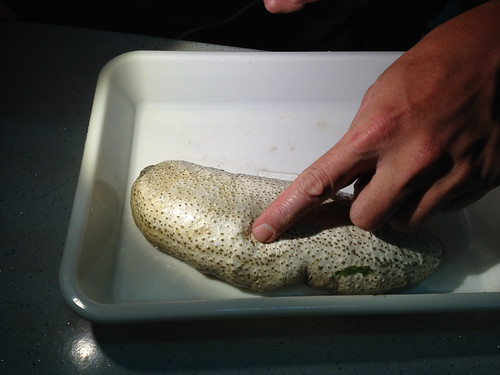
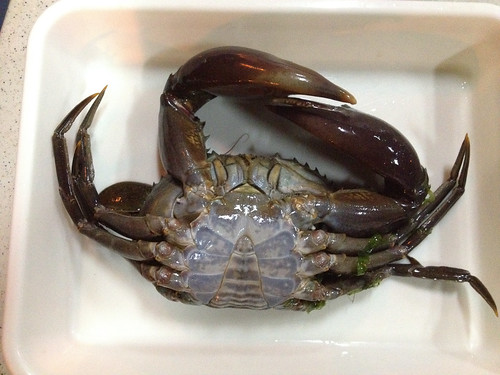
Another notable find from Chek Jawa was a purple mud crab (Scylla tranquebarica). Unfortunately, it had just moulted and its carapace was still soft, resulting in a critical injury. The dying crab was quickly sent over for tissue extraction.
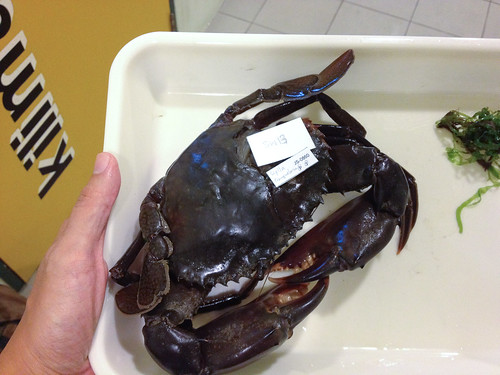
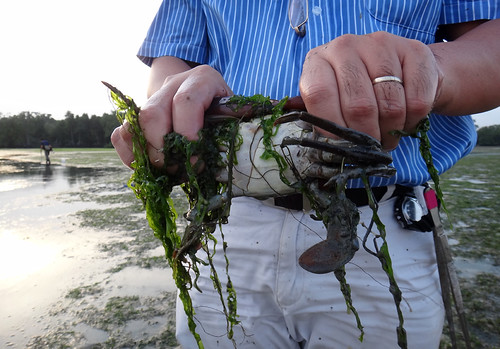
Another purple mud crab had put up a fierce fight. Professor Peter Ng, who specialises in crabs, demonstrates his method of disarming feisty specimens that resist capture;
(Photo by Marcus)
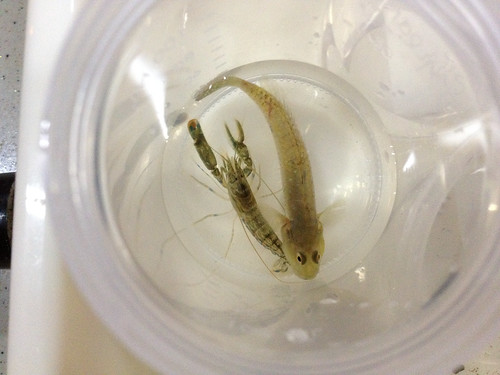
Many species of gobies (F. Gobiidae) live together with snapping shrimps (F. Alpheidae).
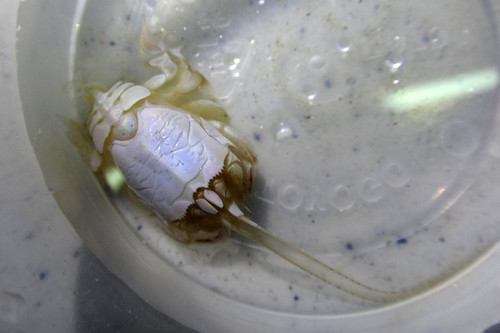
Another interesting find from Chek Jawa was this Groening crab (Albunea groeningi). First recorded from Chek Jawa in 2003, this is only the second or third example of this species found locally. And yes, this species was named after Matt Groening, creator of ever-popular animated television series The Simpsons and Futurama;
(Photo by Marcus)
The Tuas team finally returned, and it was time for some of us to leave Pulau Ubin and head back home. Much of the work is going to continue through the night.
I tweeted a lot about what I saw, using the hashtag #MegaMarine. Ichthyologist Professor Prosanta Chakrabarty (@LSU_FISH) is one of the visiting scientists offering his expertise to the Expedition, and he has also been giving some updates via Twitter - he's got more photos of the various fishes collected around Pulau Ubin so far.

Marcus shares more about what transpired over at Chek Jawa in his post, while Ria has written about some of the things found at Tuas. Jerome also has a Facebook album with more photos. He's even got a couple of videos of a group of smooth otters (Lutrogale perspicillata) that were spotted off Punggol Jetty during the morning field session!
The Mega Marine Survey Facebook page should also have regular updates about the Expedition.
More field surveys tomorrow; who knows what we'll find?